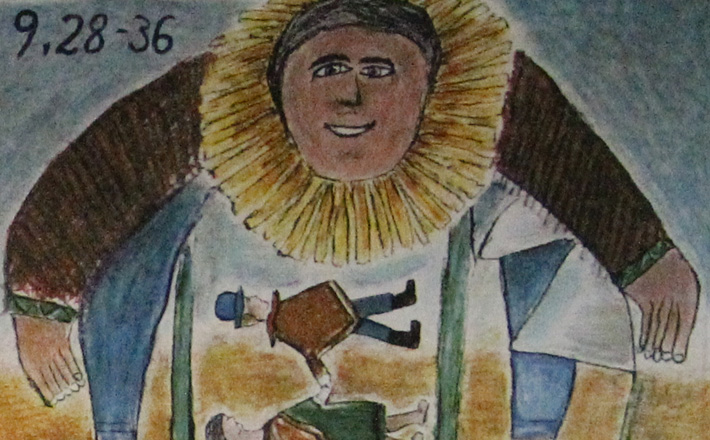Commentary on 2 Corinthians 3:12—4:2
Every second reading for Transfiguration from 2 Corinthians comes after the next.
Confusing? In an interesting coincidence, the lectionary for Transfiguration in Year B (February 22, 2009) and Year C (February 14, 2010), takes successive reading from 2 Corinthians, but in reverse order. Last Transfiguration, the reading was 2 Corinthians 4:3-6, and for this year it is 2 Corinthians 3:12-4:1. At first, this may not seem like something worth noting, but the connection between the two texts and the significance of reading them on Transfiguration are interesting.
In 2 Corinthians 3:13-18, the word “veil” (kalumma) occurs four times, in each of the verses except seventeen. There is the veil that Moses wore over his face after his visage had been transformed by his encounter with God. After speaking to God in the tent of meeting, Moses would put on his veil to avoid making the Israelites uncomfortable; it seems that when they saw his face shining with the glory of his encounter with God they were afraid (Exodus 34:29-35), and, as their own faces were still shining from the exertion of reveling before the Golden Calf (Exodus 32), they were probably ashamed by the comparison as well.
Paul takes this story of Moses’ veil and uses it as an allegory for reference to the old covenant (3:14)–which is only set aside in Christ (i.e. the gospel)–and for the reading of “Moses” (3:15, which is a euphemism for the Torah, or Pentateuch)–which is only comprehensible when one turns to God (3:16). In both cases, Paul is making the claim that the old covenant, the old “good news,” cannot be properly understood and accepted until the veil is removed. Then we ourselves with faces unveiled–which at this point is both a reference again to the Moses story, and metaphor for hearts and minds that are set free by the Holy Spirit (3:18)–will finally know the glory of God.
For Paul, this is again a statement of the gospel and its power to create faith and give life. This then is Pauline, Christian ministry, the removing of veils by “the open statement of the truth” (4:2).
Before moving on with the image of the veil, it may be necessary to say a quick word about the inter-testamental tension here. There may be a tendency, and perhaps even a temptation, to read this allegory of Paul’s as an outright rejection of the Old Testament. Phrases like “not like Moses,” and “their minds were hardened,” and even simply the “old covenant,” may seem to suggest that Paul is doing exactly this, rejecting “Moses” and his obscured, clouded, veiled word. But for Paul, there is no true disconnect between the Torah and the Testament to Christ. As the second reading from last week showed the gospel (or as 2 Corinthians 3:12-4:2 has it, the truth) is very much in keeping with the Old Testament, with the scriptures of the tradition.
At stake here are questions of antinomianism, of supersessionism, of simplistic ideas of “Old Testament = Law, bad and New Testament = Gospel, good.” Along with these often goes “Christian believer = good, Jewish believer = bad.” This is not, finally, what Paul is about. Paul does not dismiss the Old Testament.
At the same time the essential claim for Christ is an essential claim, it is particular, and quite uncompromising. While Paul does not reject the Old Testament, the old covenant, he does argue for a particular reading of it, one that is possible only in the Spirit, who brings freedom from blindness, and veiled minds (3:17). These are not simple matters to come to grips with, and are certainly not easily handled in the pulpit (a move that I would almost certainly avoid myself). But these issues ought to inform the preacher as she engages this text carefully and prayerfully.
Back to the veil at hand. Were we to continue reading in 2 Corinthians 4, we would read more about the veil, and its relationship to the gospel of Christ. The text of 2 Corinthians 4:3-6 bears re-reading,
“And even if our gospel is veiled, it is veiled to those who are perishing. 4 In their case the god of this world has blinded the minds of the unbelievers, to keep them from seeing the light of the gospel of the glory of Christ, who is the image of God. 5 For we do not proclaim ourselves; we proclaim Jesus Christ as Lord and ourselves as your slaves for Jesus’ sake. 6 For it is the God who said, ‘Let light shine out of darkness,’ who has shone in our hearts to give the light of the knowledge of the glory of God in the face of Jesus Christ.”
Paul’s case is for both the reality and the need for an unveiling of the heart in relationship to the gospel. This is the goal, with great boldness and open statement of truth (3:12; 4:2) toward which Paul himself presses, and to which he urges us who hear this proclamation. If we turn to the Lord, the veil is removed.
God is all about de-veiling; this is what the book of Revelation is, not so much about the end of the world, but the end of worldly vision a removing of the veil (apokalupsis). And this is what, in Christ, makes the covenant, no so much new as opposed to old, but the old made new as this veil is set aside.
So what then is the result of this de-veiling of sight, mind, and faith? The result is transformation, or perhaps better, transfiguration. 2 Corinthians 3:18, “And all of us, with unveiled faces, seeing the glory of the Lord as though reflected in a mirror, are being transformed…”
All of us with faces unveiled (anakekalummenō), are being transformed (metamorphoumetha). This last word, metamorphoumetha, is the same word used in Matthew’s account of the Transfiguration to describe what it is that happens to Jesus, in the eyes of the disciples; he is transformed, transfigured. As though the veil is removed from his face, or more accurately from their sight and their minds, the disciples see who Jesus is clearly, “the glory of the Lord as though reflected in a mirror” (2 Corinthians 3:18). Luke 9:29 does not use this same word, so the preacher ought not to stress unduly the relationship of 2 Corinthians and Luke1. There is, however, a similar sense of transformation taking place, wherein the vision and understanding of the disciples is transformed by the work of Jesus, and the power of the Spirit.
For the reader, preacher and hearer of 2 Corinthians 3:12-4:2, it is this transformed vision, faith, and (as a result) life that it at the fore. Our preaching on this Sunday, the “transfiguration” which is so often difficult to understand and perhaps harder to explain, is well served by this text from Paul, which offers a transformation/transfiguration in the very same image of glory that is shown in the transfigured, transformative glory of Christ.
1Luke describes the transfiguration simply as Jesus’ appearance “becoming…other” (egeneto …heteron).


February 14, 2010